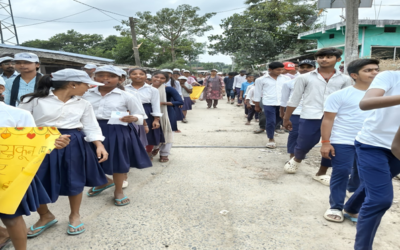I always found my school days boring as I never really enjoyed classroom learning, which now seems quite rigid. During my college days, I came across the NCERT books and a few websites for Creativity Learning. I found them interesting and was motivated to use this as an opportunity to implement these creative learning ideas. Finally, I got to do it here in ‘Gyanodaya – Back to School Program’ while working with Shiksharth in Sukma, Chhattisgarh.
People at Shiksharth believe in ‘learning with fun’ which includes outdoor activities, crafts, games and more. I was fond of ‘snakes and ladders’ as well as ‘Ludo’ in my childhood but I never thought that it would help us develop our number sense. The dots on a dice helps with counting when a child converts those dots into numbers on game board. It also lets them form a sequence of numbers. Here, we have designed ‘Saanp Seedhi‘ (Snakes and Ladders) of 20 and 30 blocks for the kids of level 1 and have increased the complexity as per their level.
Another factor in learning includes proper communication and overcoming the language barrier, if any. It plays an essential role in the development of children. I recently got to attending an ‘Early Language Learning’ workshop organized by Vikramshila which enabled me to build my understanding about importance of language and how children learn them.
We then conducted an activity named ‘feely bag’, to introduce the sound of letters. In this, we carried a bag full of all the items whose names start with ‘म’ for e.g. मछली, मिर्ची, महुआ, माला, मोमबत्ती. The students were supposed to put their hand inside the bag, touch the objects, feel them and guess what’s what. They all had fun doing this activity. Later on, we asked them to say the name of the objects out loud and focus on the first sound of each word. Then, we wrote ‘म’ on the board and asked kids to think of more words starting with the same sound. They participated energetically and that’s how a fun activity also became a learning session.
Alphabet cards are other useful TLMs (Teaching Learning Material). We can start with kids having to identify the letters and once they become comfortable with that, we can create a matching game out of it. In this, we divide them in small groups and give them cards with a letter written on each. Then an alphabet is called out, and kids find the card with that alphabet. Those who face difficulty in doing so, learn through this activity.
Clay Art is something that I love, since my childhood. With a thought of introducing it to my kids, I brought clay to my classroom and kids started wondering what it was. A few of them thought it was a kind of soap. When they first touched it, they were disgusted with its texture and stickiness. While explaining them what clay is, I also made an idol of lord Ganesha and they all started dancing on ”Ganpati Bappa Moraya!”
Eventually, they followed the steps and made a Ganesha idol for themselves. Next time, I asked kids to make one clay alphabet each and share it with others. They started interacting and discussing alphabets. After a few days, they wrote their names with clay and were amazed by that. It was also used in addition and subtraction. Clay is now one of their favorite things ever. They request me to get it to the class every day. These are children from different age groups, distinct learning pace, and to make sure that no one is left behind, we work together. Peer learning helps here, and so did clay.


Clay art by one my kids

To make English fun, we had a small give and take session where we got into a deal that I will teach them the name of the animals in English and in return, they will teach it to me in Gondi. This really helped me to know how difficult it is to remember even 7-8 names in a completely foreign language. To make it more interesting, I’d call out the name of an animal in Gondi or Hindi and the kids would imitate the sound or an action of the animal.
‘Mandala Art’ is another unique concept I came across during our Mid-Point training of India Fellow. I got so mesmerized with it that I immersed myself into it deeply and it became a source of joy in my me-time. It was a kind of meditation that strengthened my power of concentration. I then decided to do it with my kids. Initially, I thought it would make them sit for longer duration as these kids are used to an open environment which makes it difficult for them to sit in closed spaces for more than 20 minutes. When I introduced Mandala art in my class, they did for more than 35 minutes with absolute silence. It stabilized them while they repeated the same patterns. In one session, we used English alphabets as design patterns and it worked really well. Many kids learnt to draw the shapes of alphabets with which they were struggling earlier.

Teaching with such activities and adapting the ‘fun & learn’ method has surely made a positive impact on children’s participation. Books and blackboard shouldn’t be the only sources of obtaining knowledge.
“What we learn with pleasure we never forget.” – Alfred Mercier.




Enjoyed reading this Sandesh. Well supported with pictures. I’d love to try feely bag 🙂
Thank you very much Swati 🙂
Creativity at its best🎉🥳❤️